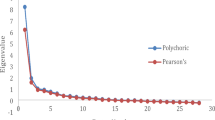Abstract
The Gender Role Journey concept was developed to help women and men explore their gender role changes and transitions. A 34-item Gender Role Journey Measure (GRJM) was conceptualized and developed through empirical methods. The construct validity of the five phases of the gender role journey is assessed. The GRJM and the Personal Attributes Questionnaire (PAQ) were given to a sample of women and men (N=878). The sample was predominantly Caucasian from a mixed ethnic background. Principle factor analysis indicated three meaningful factors: Acceptance of Traditional Gender Roles; Gender Role Ambivalence, Confusion, Anger, and Fear; and Personal-Professional Activism. Moderately high test-retest and internal consistency reliabilities were found for each of the factors. Gender differences and gender by PAQ interactions were found for all three of the factors of the GRJM. Implications for future research, teaching, and workshops are suggested.
Similar content being viewed by others
References
Albee, G. W. (1981). The prevention of sexism. Professional Psychology, 12, 20–28.
Archer, J. (1984). Gender roles as developmental pathways. British Journal of Social Psychology, 23, 245–256.
Bargad, A., & Hyde, J. S. (1991). Women's studies: A study of feminist identity development in women. Psychology of Women Quarterly, 15, 181–201.
Basow, S. A. (1986). Gender stereotypes: Traditions and alternatives. Monterey, CA: Brooks/Cole.
Bem, S. L. (1974). The measurement of psychological androgyny. Journal of Consulting and Clinical Psychology, 42, 155–162.
Bernard, J. (1975). Sex role transcendence and sex role. In J. Bernard (Ed.), Women, wives, mothers, and options. Chicago: Adline.
Block, J. H. (1973). Conceptions of sex role: Some cross-cultural and longitudinal perspectives. American Psychologist, 28, 512–526.
Block, J. H. (1984). Sex role identity and ego development. San Francisco, CA: Jossey-Bass.
Cohen, J. (1988). Statistical power analysis for behavioral sciences. Hillsdale, NJ: Lawerence Earlbaum Associates.
Eccles, J. S. (1987). Adolescence: Gateway to gender-role transcendence. In D. B. Carter (Ed.), Current conceptions of sex roles and sex typing: Theory and research. New York: Praeger.
Egan, J. (1990). Men and women in organizations: A course on gender role socialization and its impact on adult learners. Unpublished paper, Asnuntuck Community College, Enfield, CT.
Finn, J. (1986). The relationship between sex role attitudes and attitudes supporting marital violence. Sex Roles, 14, 235–244.
Finkelhor, D. (1984). Child sexual abuse: New theory and research. New York: Free Press.
Giele, J. Z. (1980). Adulthood as transcendence of age and sex. In N. J. Smelser & E. H. Erickson (Eds.), Themes of work and love in adulthood. Cambridge, MA: Harvard University Press.
Helmreich, R. L., Spence, J. T., & Wilhelm, J. A. (1981). A psychometric analysis of the Personal Attributes Questionnaire. Sex Roles, 7, 1097–1094.
Levinson, D. J., Darrow, C. H., Klein, E. B., Levinson, M. H., & McKee, B. (1978). The seasons of a man's life. New York: Ballantine Books.
Martin, C. L., & Halverson, C. F. (1987). The role of cognition in sex role acquisition. In D. B. Carter (Ed.), Current conceptions of sex roles and sex typing. New York: Praeger.
Moreland, J. R. (1976). Facilitator training for consciousness raising groups in an academic setting. Counseling Psychologist, 6, 66–68.
Moreland, J. R. (1980). Age and change in the adult male sex role. Sex Roles, 6, 807–818.
Nunnally, J. C. (1978). Psychometric theory (2nd ed.). New York: McGraw-Hill.
O'Neil, J. M. (1990). Assessing men's gender role conflict. In D. Moore & F. Leafgren (Eds.), Men in conflict: Problem solving strategies and interventions. Alexandria, VA: American Association for Counseling and Development Press.
O'Neil, J. M., & Egan, J. (1992a). Men's gender role transitions over the life span: Transformations and fears of femininity. Journal of Mental Health Counseling, 14, 306–324.
O'Neil, J. M., & Egan, J. (1992b). Men's and women's gender role journeys: A Metaphor for healing, transition, and transformation. In B. Wainrib (Ed.), Gender issues across the life cycle. New York: Springer Publishing.
O'Neil, J. M., & Fishman, D. M. (1986). Adult men's career transitions and gender role themes. In Z. Leibowitz & D. Lea (Eds.), Adult career development: Concepts, issues, and practices. Alexandria, VA: American Association for Counseling and Development.
O'Neil, J. M., Fishman, D. M., Kinsella-Shaw, M. (1987). Dual-career couples' career transitions and normative dilemmas: A preliminary assessment model. The Counseling Psychologist, 15, 50–96.
O'Neil, J. M., & Roberts Carroll, M. (1987). A six day workshop on gender role conflict and strain: Helping men and women take the Gender Role Journey. Storrs, CT: University of Connecticut, Department of Educational Psychology, Counseling Psychology Program. (ERIC Document Reproduction Service No. ED 275963.)
O'Neil, J. M., & Roberts Carroll, M. (1988a). A gender role workshop focused on sexism, gender role conflict, and the gender role journey. Journal of Counseling and Development, 67, 193–197.
O'Neil, J. M., & Roberts Carroll, M. (1988b). Evaluation of gender role workshop: Three years of follow-up data. Paper presented at the 95th convention of the American Psychological Association, New York, September, 1987. (ERIC Document Reproduction Service No. ED 287121.)
Rebecca, M., Hefner, R., & Olenshansky, B.A. (1976). A model of sex-role transcendence. Journal of Social Issues, 32, 197–206.
Russell, D. E. (1984). Sexual exploitment: Rape, child, sexual abuse, and workplace harassment. Beverly Hills, CA: Sage Publications.
Spence, J. T., & Helmreich, R. L. (1978). Masculinity and femininity: Their psychological dimensions, correlates, and antecedents. Austin: University of Texas Press.
Spence, J. T., & Helmreich, R. L. (1980). Masculine instrumentality and feminine expressiveness: Their relationship with sex role attitude and behaviors. Psychology of Women Quarterly, 5, 147–163.
Author information
Authors and Affiliations
Rights and permissions
About this article
Cite this article
O'Neil, J.M., Egan, J., Owen, S.V. et al. The gender role journey measure: Scale development and psychometric evaluation. Sex Roles 28, 167–185 (1993). https://doi.org/10.1007/BF00299279
Issue Date:
DOI: https://doi.org/10.1007/BF00299279




